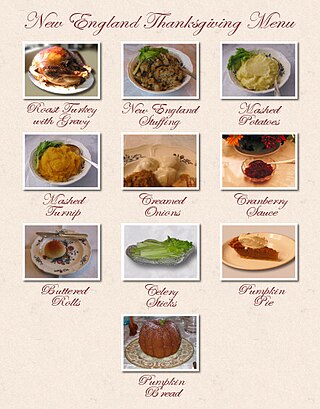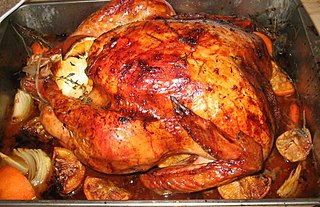
Dessert is a course that concludes a meal. The course consists of sweet foods, such as cake, biscuit, ice cream and possibly a beverage such as dessert wine and liqueur. Some cultures sweeten foods that are more commonly savory to create desserts. In some parts of the world there is no tradition of a dessert course to conclude a meal.

New England cuisine is an American cuisine which originated in the New England region of the United States, and traces its roots to traditional English cuisine and Native American cuisine of the Abenaki, Narragansett, Niantic, Wabanaki, Wampanoag, and other native peoples. It also includes influences from Irish, French-Canadian, Italian, and Portuguese cuisine, among others. It is characterized by extensive use of potatoes, beans, dairy products and seafood, resulting from its historical reliance on its seaports and fishing industry. Corn, the major crop historically grown by Native American tribes in New England, continues to be grown in all New England states, primarily as sweet corn although flint corn is grown as well. It is traditionally used in hasty puddings, cornbreads and corn chowders.

An apple pie is a pie in which the principal filling is apples. Apple pie is often served with whipped cream, ice cream, custard or cheddar cheese. It is generally double-crusted, with pastry both above and below the filling; the upper crust may be solid or latticed. The bottom crust may be baked separately ("blind") to prevent it from getting soggy. Deep-dish apple pie often has a top crust only. Tarte Tatin is baked with the crust on top, but served with it on the bottom.

Cheesecake is a dessert made with a soft fresh cheese, eggs, and sugar. It may have a crust or base made from crushed cookies, graham crackers, pastry, or sometimes sponge cake. Cheesecake may be baked or unbaked, and is usually refrigerated.

Trinidad and Tobago has a unique history and its food is influenced by Indian-South Asian, West African, Creole, European, American, Chinese, Amerindian, and Latin American culinary styles. Trinidadian and Tobagonian food is dominated by a wide selection of dishes, most notably, doubles, roti, pelau, callaloo and curried crab and dumplings. Trinidad and Tobago is also known for its prepared provisions, such as dasheen, sweet potato, eddoes, cassava, yam, soups and stews, also known as blue food across the country. Corresponding to the Blue Food Day event held annually in Trinidad and Tobago.

Entenmann's is an American company that manufactures baked goods and delivers them throughout the United States to supermarkets and other retailers for public sales. Often, they are known to have display cases at the end of store aisles. The company offers dessert, cup, loaf, and crumb cakes, and donuts, cookies, pies, cereal bars, muffins, Danish pastries, and among other baked goods, buns. In the past several years, they have added designer coffee flavors along with scented candles to their product line in an effort to broaden its appeal.

The centerpiece of contemporary Thanksgiving in the United States is Thanksgiving dinner, a large meal generally centered on a large roasted turkey. Thanksgiving could be considered the largest eating event in the United States as measured by retail sales of food and beverages and by estimates of individual food intake. People often consume as much as three or four thousand calories during the course of the dinner.

Christmas dinner is a meal traditionally eaten at Christmas. This meal can take place any time from the evening of Christmas Eve to the evening of Christmas Day itself. The meals are often particularly rich and substantial, in the tradition of the Christian feast day celebration, and form a significant part of gatherings held to celebrate the arrival of Christmastide. In many cases, there is a ritual element to the meal related to the religious celebration, such as the saying of grace.

Cinnamon sugar is a mixture of ground cinnamon and granulated sugar used as a spice to flavor foods such as Belgian waffles, Snickerdoodle cookies, tortillas, coffee cake, French toast, and churros. It is also used to flavor apples, cereals, and other fruits. As McCormick describes cinnamon sugar, "it’s the comforting scent of Sunday morning cinnamon toast and mid-summer’s peach cobbler...the aroma of the holidays, with cinnamon cookies and spice cake."

Pumpkin pie is a dessert pie with a spiced, pumpkin-based custard filling. The pumpkin and pumpkin pie are both a symbol of harvest time, and pumpkin pie is generally eaten during the fall and early winter. In the United States and Canada it is usually prepared for Thanksgiving, Christmas, and other occasions when pumpkin is in season.

Charles Phoenix is an American pop culture humorist, historian, author and chef whose work explores 1950s and 1960s kitsch and Americana.
Zac Young is an American pastry chef and TV personality. He has been featured on various baking shows on Food Network and the Cooking Channel, most notably on Top Chef: Just Desserts and Unique Sweets. He also appeared as a guest judge on baking competition show Nailed It! on Netflix, Food Network's Halloween Baking Championship, and Food Network's Chopped.
Pie in American cuisine has roots in English cuisine and has evolved over centuries to adapt to American cultural tastes and ingredients. The creation of flaky pie crust shortened with lard is credited to American innovation.

A dump cake is an American dessert similar to a cobbler but with a cake-like topping. It is so named because it is prepared by "dumping" ingredients into a cake pan without mixing.












